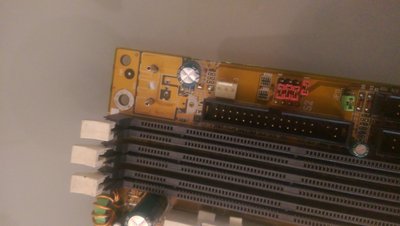First post, by meljor
Hi,
I rescued a MS5169 ver:2.1 AL9 super socket 7 board with Ali chipset from a scrapper. But it was wounded already so it has these problems i need to fix:
On the photo you can see that it is missing a alu heatsink which had a component attached (2 pins are still there, the rest is torn of for the alu). I'm not good with electronics but i can fix this if i know what needs to be placed there.
I think it is some kind of voltage regulator? Any way, if anybody has the same revision of this board then please can you tell me what's missing? I assume there's also a cap missing next to the other one.
Last but not least: It's missing the bios chip (they always rip them off). I do not have the same board laying around otherwise a hotflash would be no problem. Can it be done on a DIFFERENT board and just force the flash??
I see all kinds of cheap eeprom flash devices from china but which one do i need to be able to flash 486/p1/p2/p3 bios chips? Which chips do i need to order for these boards?
Thank you!
asus tx97-e, 233mmx, voodoo1, s3 virge ,sb16
asus p5a, k6-3+ @ 550mhz, voodoo2 12mb sli, gf2 gts, awe32
asus p3b-f, p3-700, voodoo3 3500TV agp, awe64
asus tusl2-c, p3-S 1,4ghz, voodoo5 5500, live!
asus a7n8x DL, barton cpu, 6800ultra, Voodoo3 pci, audigy1

 picture it seems to have the Winbond W29EE011 chip, which is quite popular, affordable and programmer-friendly. Near the flash chip there is a JP8 jumper which is not documented in the manual but I guess it's the selector for 5V or 12V flash chips, but better stay with 5V chips because many boards and cards can't flash 12V chips unless you wire 12V directly to the VPP.
picture it seems to have the Winbond W29EE011 chip, which is quite popular, affordable and programmer-friendly. Near the flash chip there is a JP8 jumper which is not documented in the manual but I guess it's the selector for 5V or 12V flash chips, but better stay with 5V chips because many boards and cards can't flash 12V chips unless you wire 12V directly to the VPP.